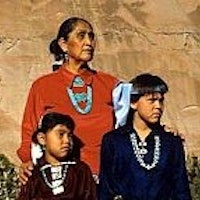With beauty may I walk. With beauty before me, may I walk. With beauty behind me, may I walk. With beauty above me, may I walk. With beauty below me, may I walk. With beauty all around me, may I walk.
The Diné (Navajo) people

With Beauty May I Walk
Topic: The Natural World
In beauty may I walk.
All day long may I walk.
Through the returning seasons may I walk.
On the trail marked with pollen may I walk.
With grasshoppers about my feet may I walk.
With dew about my feet may I walk.
With beauty may I walk.
With beauty before me, may I walk.
With beauty behind me, may I walk.
With beauty above me, may I walk.
With beauty below me, may I walk.
With beauty all around me, may I walk.
In old age wandering on a trail of beauty, lively, may I walk.
In old age wandering on a trail of beauty, living again, may I walk.
It is finished in beauty.
It is finished in beauty.
Hózhó náhásdlíí
The Diné (Navajo) people are an Indigenous nation whose traditional homeland, Dinétah, lies in the Four Corners region of what is now the United States. They call themselves Diné, meaning “The People,” and speak Diné Bizaad, a Southern Athabaskan language related to the languages of other Dene peoples in Alaska and northwestern Canada. Linguists and archaeologists describe the Diné as descendants of Athabaskan-speaking peoples who migrated south from the subarctic and arrived in the Southwest roughly 800–1,000 years ago. In their own creation stories, the Diné tell of emerging through earlier worlds into the present “Glittering World,” bounded by four sacred mountains, and of receiving teachings for living in balance with Mother Earth and Father Sky. Over time, the Diné adopted corn, beans, and squash agriculture from Pueblo neighbors and, after Spanish contact, incorporated sheep and horses into their way of life, developing a pastoral economy in which weaving and herding became central.
The 19th century brought severe disruption and violence. After the United States took control of the Southwest from Mexico in 1848, military campaigns increasingly targeted Diné homelands. In 1863–1864, under General James Carleton, Colonel Kit Carson carried out a scorched-earth campaign in Dinétah, burning fields and hogans and killing or seizing livestock to force surrender. Beginning in 1864, more than 8,500–10,000 Diné men, women, and children were forced on the Long Walk, marching over 300 miles in winter from their homelands in present-day Arizona and New Mexico to Bosque Redondo at Fort Sumner, New Mexico. Thousands died during the marches and the four difficult years of internment. On June 1, 1868, Diné leaders signed the Treaty of Bosque Redondo, allowing survivors to return to a portion of their homeland and establishing the initial reservation of about 3.5 million acres, a turning point that began the modern Navajo Nation and a long period of cultural and spiritual rebuilding.
Since that time, the Diné (Navajo) people have expanded their land base and renewed their lifeways while facing new pressures. Today, the Navajo Nation encompasses roughly 27,000 square miles across Arizona, New Mexico, and Utah, making it the largest reservation in the United States, with its capital at Window Rock, Arizona. With several hundred thousand enrolled tribal citizens and many residents on Navajo land, it is also one of the most populous Indigenous nations in North America. The Diné have traditionally organized life through matrilineal clans, with women owning most livestock and homes, and the hogan—a sacred dwelling whose door faces the east—remaining central to ceremonial and family life. The core Diné value of Hózhó—often translated as “walking in beauty,” or living in harmony and balance—continues to guide ceremonial healing and daily conduct. From weaving and land-based knowledge to the service of Navajo Code Talkers in World War II, whose use of Diné Bizaad created a secure military code in the Pacific theater, the Diné (Navajo) people carry forward a history marked by endurance, cultural creativity, and spiritual depth.
Walking In Beauty Song (The Diné)
Wilson, Andrew, editor. World Scripture II. Universal Peace Federation, 2011, p. 159 [Walking In Beauty Song, The Navajo People (The Diné)].

The Diné (Navajo) people
Theme: Beauty

About This Walking In Beauty Song From The Diné [Navajo] People [Commentary]
The Diné (Navajo) people begin this prayer simply: “In beauty may I walk. / All day long may I walk. / Through the returning seasons may I walk.” Walking here is more than movement; it is a way of living inside Hózhó, the Diné reality of balance, harmony, goodness, and beauty. The prayer continues, “On the trail marked with pollen may I walk. / With grasshoppers about my feet may I walk. / With dew about my feet may I walk.” These lines keep the focus on the earth itself: pollen, insects, and dew are not background images but signs that the path is blessed and that ordinary ground is already sacred. Every person—of any age or gender—is invited to take part in this way of walking “all day long” and “through the returning seasons.”
The central lines turn to direction and orientation: “With beauty before me, may I walk. / With beauty behind me, may I walk. / With beauty above me, may I walk. / With beauty below me, may I walk. / With beauty all around me, may I walk.” In a few short phrases, the Diné (Navajo) people hold together past and future, height and depth, inner and outer surroundings. Nothing is left outside this circle. In their healing ways, illness or trouble comes when a person is “out of harmony, out of the Creator’s plan of beauty for the world.” To repeat “with beauty…may I walk” in every direction is to ask that the Creator’s order be restored in body and spirit, in relationship with the Holy People, the land, and the community. Memory, hope, Father Sky, and Mother Earth are all quietly gathered into this one movement of walking.
The prayer then stretches this same path across a whole life: “In old age wandering on a trail of beauty, lively, may I walk. / In old age wandering on a trail of beauty, living again, may I walk.” Here, elders are not pushed aside; in old age they are still “lively” and “living again” on the “trail of beauty.” The closing lines—“It is finished in beauty. / It is finished in beauty. / Hózhó náhásdlíí”—do more than end the chant. They affirm that what has been prayed for has already begun: it has become beauty again. Hózhó náhásdlíí, often used like “Amen,” seals the prayer in trust that, even after hardship or conflict, the world can be brought back into right relationship. From morning through the “returning seasons,” and from youth into old age, the Diné (Navajo) people keep returning to this simple, steady promise: “With beauty may I walk.”
Walking In Beauty Song, The Diné [Navajo] People
Leon Podles
Another Variant of the Walking In Beauty Song
O’siyo: The following traditional prayer is from the Navajo People [the Dine’] and can be found in many places. The original author of this beautiful blessing is unknown. Some say that reading the words bring peace and calm. We have found this to be true…
Walking in Beauty: Closing Prayer from the Navajo Way Blessing Ceremony:
Linguistic Note
Hózhóogo naasháa doo Shitsijí’ hózhóogo naasháa doo Shikéédéé hózhóogo naasháa doo Shideigi hózhóogo naasháa doo T’áá altso shinaagóó hózhóogo naasháa doo Hózhó náhásdlíí’ Hózhó náhásdlíí’ Hózhó náhásdlíí’ Hózhó náhásdlíí’
Linguistic Note: The word “Hozho” in Dine’ (roughly translated) Concept of Balance and Beauty. Consideration of the nature of the universe, the world, and man, and the nature of time and space, creation, growth, motion, order, control, and the life cycle includes all these other Navajo concepts expressed in terms quite impossible to translate into English. Some Navajos might prefer the term: “Nizhoni” meaning ‘just beauty.”
—Robert S. Drake, for Tom Holm, Ph.D. [University of Arizona American Indian Graduate Studies Program, Native American Religions and Spirituality].
Resources
Related Quotes
Copyright © 2017 – 2025 LuminaryQuotes.com About Us